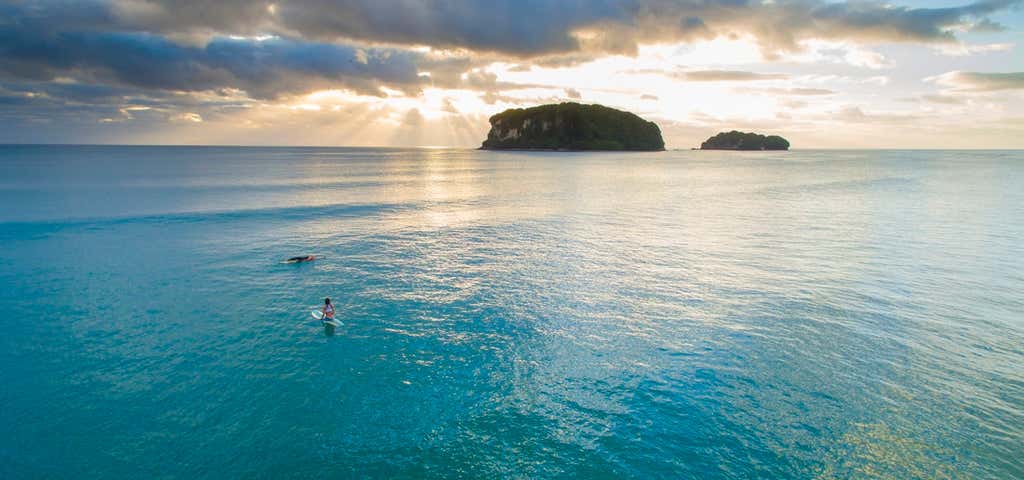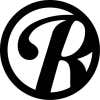The North Island of New Zealand is considered in Maori mythology to be the great fish that was caught by demigod, Maui, when he was fishing from his canoe, which was the South Island. He hauled up the North Island and his brothers hacked at the great fish, carving valleys and mountains into its flanks. Many moons later, this island, the world’s 14th largest, has a convoluted coastline that spills out into the Tasman Sea in the west and the South Pacific Ocean in the east. The Tasman fills with swells generated in the Southern Ocean and the occasional tropical cyclone from the north or off the east coast of Australia. The South Pacific Ocean does the same, but also picks up swells as slow-moving highs meander away to the east. No matter which way you look at it, Te Ika a Maui, or the fish of Maui, was one hell of a catch. Here’s 10 of the best surf spots for your bucket list.
Piha Beach
Piha is considered the birthplace of modern surfing in New Zealand thanks to a couple of Americans, Rick Stoner and Bing Copeland, visiting in 1958 and teaching the locals how to build their own boards. The stunning West Coast nook, just a 40-minute drive from Auckland, collects every scrap of swell in the Tasman Sea – usually too much through winter. The Piha Bar, located in the southern corner is the holy grail here. It can handle large swells up to three-times overhead and reels like a point break with barrel sections and walls that seem to grow on you. The left is one of the most iconic waves on the coast, but getting out to it is no easy task. On small days a little rip runs against the rocks and can deliver you into the line-up. On bigger days the better option is to paddle, at mid-low-tide, through a cave called the Keyhole and run the gauntlet at its entrance – an adrenaline-fueled sprint that will test your timing. Get it right and you’ll have dry hair. Get it wrong and you may end up on TV. Due to the currents and rips that terrorise beach goers at Piha, there is now a TV series dedicated to those who perform the rescues.
Whangamata Bar
Like Northland’s East Coast but with the swell dial cranked up a few clicks, the Coromandel Peninsula is a surfing haven with reefs and beach breaks that can go from dead flat to scary hollow in a matter of hours. They rely on the tropical cyclones to fire properly, but even the close proximity storm cells that sweep New Zealand can produce quality waves. The gem in the Coromandel crown is the Whanga Bar. Formed by the tidal currents of the Whangamata Harbour, Whanga Bar is a left-hander (with an occasional short right) that peaks on the sand bank, producing a demanding take-off, followed by a super hollow first section before the wall just keeps coming. There is often a sweep through the take-off zone and it’s easiest to paddle out through the harbour channel. It handles surprisingly big swell. Locals here are very friendly, but always show respect in the line-up. A little driving, walking and a nose for adventure may unearth a few hidden gems along this coast.
Matakana Island
Mount Maunganui is renowned for its beautiful beaches, which offer some quality surf at times, but mostly they’re the perfect stomping ground for grommets and beginners. Across the Tauranga Harbour mouth from the actual mountain, Mauao, lies Matakana Island. Carpeted with pine trees, Matakana Island’s exposed east coast is the performance end of the Mount Maunganui surfing experience. Swell is focused by outlying islands and hits the sand banks along this stretch of coast like it means it: big barrels, heavy peaks and rides of your life. And, it handles a lot of size – some savvy Island surfers claim it just gets better the bigger it gets. You’ll need a boat however, and the seamanship to know where to anchor it, because a lot of boats get swamped out the back of this little beauty.
Whakatane Heads
If you’ve got the nerve to paddle across the Whakatane Rivermouth, then you’ll be fine among the surly locals who have the Whakatane Heads right-hand point break dialled. Although it requires a big swell to break – and that doesn’t happen too frequently on this coast – if you do score Whakatane Heads in all its glory you’ll have surfed a classic. Offshore in a southerly, you’ll want to pounce on any swell window, even if it means paddling out in a slight onshore. If it’s big enough it can handle it as the wave draws off the sandbank. Further south, beyond Opotiki lies the East Cape, a wave-rich coastline with a myriad of line-ups and well worth exploring. But you’ll need two things: patience and respect for the local surfers.
Wainui Beach
While Piha holds the mantle of “birthplace of surfing in New Zealand’, few could argue that Gisborne is its beating heart. Tucked into the crook of Poverty Bay, on the southern edge of the East Cape places it directly into the firing line of the big southerly swells that wash up the east coast from the South Island. In the ’60s the community embraced the spirit of free love and free spirits. That appealed to surfers who took up residence along the super-consistent and high-quality Wainui Beach. Second generation surfers included some of New Zealand’s best: Maz and Jay Quinn, Blair Stewart, Ricardo Christie, to name a few. With days that suit everyone from grommets to seasoned barrel hunters, Wainui’s sand banks are adored. Further north the East Cape harbours some stunning line-ups and to the south, Mahia Peninsula is always worth the drive.
Castlepoint
The Wairarapa Coast dominates the south east corner of the North Island. It’s exposed, rocky, wild country and bears the full brunt of southerly swell traffic. And that’s what makes it such an incredible place for experienced surfers. There are more undiscovered surfbreaks down here than in any other part of the island. But when you can score the iconic reflecting walls of The Gap at Castlepoint, who needs to look any further? The Gap is a natural break in a rock wall near the lighthouse that lets the swell through and reflects it around the perfectly formed bay, cleaning it up and creating fun, mostly right-handers that peel into the bay. It’s an iconic surf spot, but if you want a little more size, look further north and climb the hill to the south of The Gap.
Kumera Patch
While the city of New Plymouth is home to famous surf spots like Fitzroy Beach and Back Beach, Kumara Patch, near Okato, is one of Taranaki’s best left-hand point breaks and works in any south swell and southeast winds. It's a rocky point that reels all the way into a small bay. At times sand can cover the rocks completely. It’s far enough north that it can handle a decent size and iron out the wrinkles from any close-proximity swell generators. The locals here are friendly, but have a thin tolerance for any snakes or drop-ins in the line-up. Ever since this stretch of coast got named the Surf Highway, local law has kept the peace in the water. You’ve been warned, play nice.
Manu Bay
The world-renowned left-handers of Raglan wrap around the northern fringes of Mt Karioi where the Tasman Sea meets the Whaingaroa Harbour. The jewel in the fabled points’ crown is Manu Bay. The innermost point is serviced by a beautiful carpark, boat ramp and toilet/shower/changing room block. Access to the grinding lefts couldn’t get any easier. The wave itself begins with a ledgey take-off (at low-tide, this ledge is one of the only truly heavy barrel sections produced on the Raglan points). If you make the drop you’ll want to put the hammer down until the wall finds the crux in the reef. If you make it this far it will be time to see how many re-entry’s you can fit in before the wall rolls into deep water nearer the boat ramp. Manu Bay handles everything from a huge swell to waves to stoke out ankle biters. On a big day and at low tide, it's an arena for the bravest only. And the jump rock is a thing of beauty – if you find beauty in the face of adversity that is. Good luck.
Shipwrecks Bay
Shipwreck Bay is one of New Zealand’s worst-kept secrets. The fact it featured in the 1960s cult surf movie Children of the Sun didn’t help. Either does the fact the series of left-hand reef breaks fuse adventure with remoteness and, at times, some incredible waves. That’s a concoction that is hard not to like. The first barrier to entry is the track around the coast – passable only at low tide and with a 4WD. If you make it without cracking your sump, then you’ve got a few kilometres of beach and 3-4 distinct line-ups to select from. Take your pick, but be super respectful of the locals here – they live, work and surf here. It’s their backyard and they will tolerate you if you show respect and patience. The law in this part of New Zealand is mostly self-governed. If you play nice, you’ll meet some great characters and notch up some of the best lefts of your life.
Sandy Bay
The Northland and north east coast beaches are littered with quality line-ups, but hampered by a lack of swell energy. During the summer tropical cyclone season is when you’re going to have the best chance of scoring a bay in all its glory. Just north of Whangarei on the drop-dead gorgeous Tutukaka Coast you’ll find a more consistent beach: Sandy Bay. Nestled in among pohutukawa trees and with the Poor Knights Islands standing sentry on the horizon, Sandy Bay is an iconic surf beach. It caters for all levels from frothing grommets to serious barrel hunters when the swell finds its way through the islands. If it’s dead flat, then go dive the Poor Knights Islands – rated by Jacques Cousteau as one of the top 10 dive spots in the world.
Explore More Trip Guides
Top Surf Breaks - South Island
- 10 Places
Route 66 Leg 2: St. Louis to Tulsa
- 61 Places
- 18:31
- 876 mi












